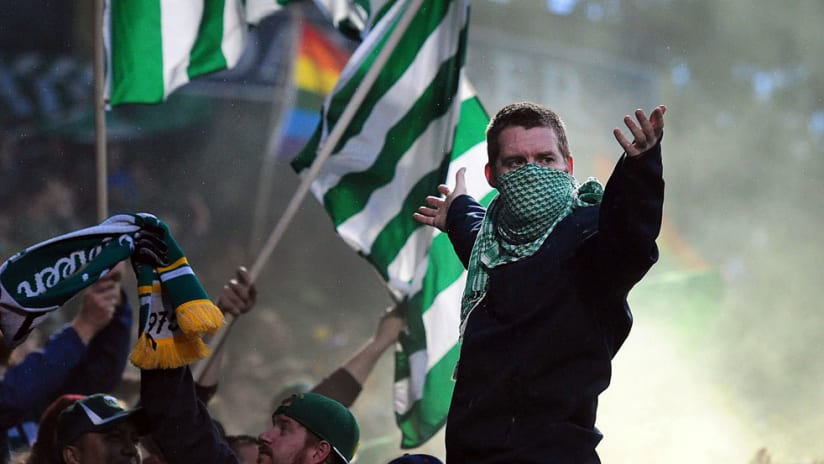During the week they’re students, bartenders, airline maintenance technicians and white-collar workers.
But when the weekend comes, their responsibilities change. Perched at the head of large swaths of their club’s most ardent fans, they serve as pseudo-orchestra directors, actively conducting their fellow supporters in organized song, chants and visual support.
They’re capos. They may not always watch the game, but they always affect it.
As some of the most recognizable faces in a club’s supporter community, each small band of capos are minor celebrities. Photographers snap candid shots. Television cameras focus in on their efforts. They’re front and center, but that prestigious position is far from the ethos of the capos themselves.
“A good capo shouldn’t care about celebrity status or personal glory,” says Pattrick Stanton, a long-time capo with Section 8 Chicago. “You’re there to lead and inspire a group of people into one voice that will help the players on the field. In order to inspire, people need to respect you as a motivational leader. If you’re in the stand to be a celebrity, you’re doing it wrong.”
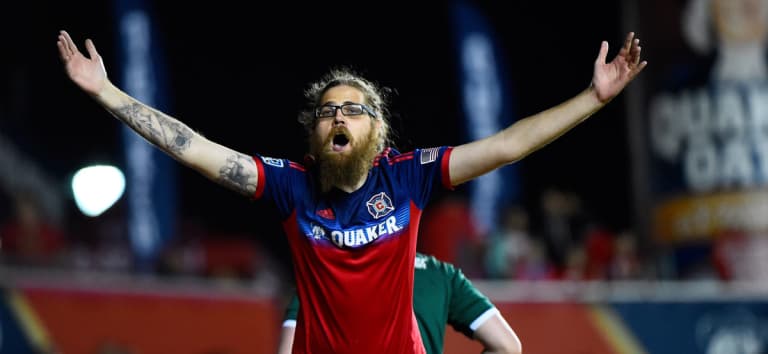
Capos rotate at Toyota Park, the home of the Fire. Section 8 Chicago has a group of 10 capos. USA Today Sports Images
Currently the longest-tenured member of a group of 10 Section 8 capos, Stanton first rose to the position in 2005 when the usual suspects couldn’t make it to a Chicago Fire friendly in Milwaukee.
“It was an opportunity for me to step in and keep everyone on the same page,” he says. “It was me working to express this raw emotion and passion I felt and at the same time help lead your team, reminding them it may be a friendly and a lot of them are young, but that this was their opportunity to prove themselves, just like it was mine.”
In Portland, Camm Murray was a college student who had an affinity for soccer and latched on to the vibrant grassroots support generate by the Timbers Army while they were still a part of USL.
“The first match I went to I sat in the section behind Timbers Army, the second match I started to get involved at the back of TA and it just became a slow progression where I eventually found myself at the front of the section with a lot of people closer to my age,” Murray remembers.
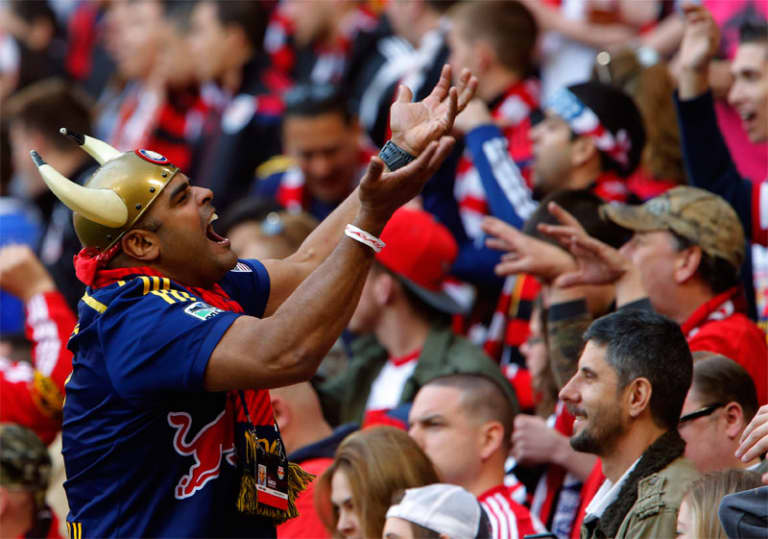
The South Ward drives the Red Bulls on each home game from Section 101, led by capos from all three supporters groups (Empire Supporters Club, Viking Army and the Garden State Ultras). USA Today Sports Images
Of course, not all clubs rely on capos to generate support. Columbus Crew SC's Nordecke is one notable exception, preferring a leadership-by-committee approach to dedicated capos.
Among those that put someone on the stand, the collection of capos is usually a small circle. Generally, there’s no secret handshake or initiation ritual, but you must prove yourself before being granted access to the stand. What that means varies between each supporters group, but the measures are in place to make sure anyone who assumes the role understands the responsibilities and privileges that go along with it.
“You make your bones in the middle of the section near the drums,” says Empire Supporters Club capo Steven Ferreza, who helps lead the South Ward during New York Red Bulls matches. “People that want to be a capo go in the middle and stay in the middle. If you see a capo that is struggling, help them out. You spend a couple of seasons in the middle and when the current capos think you’re ready, they let you know.”
“[In Portland] the most important quality when considering a capo is that they’re trustworthy,” adds Murray. “If you also prove yourself to be a trustworthy person – you come to matches, you handle yourself well, you get involved, you do volunteer work and tifo – if you make yourself known and make it a point to show that you care about what’s going on and want to make the North End a better place, that’s your in.”
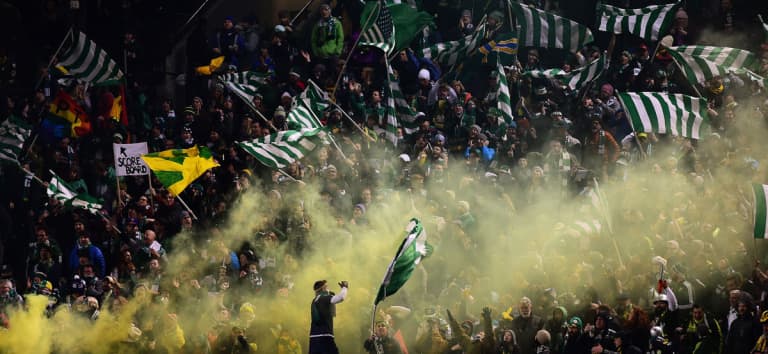
Capos are just one part of the incredible environment the Timbers Army helps create during Timbers games at Providence Park. USA Today Sports Images
In Chicago, along with meeting the minimum standard of being a Fire season ticket holder, supporting the club at an away match is also a prerequisite to occupying the iconic red stand at Toyota Park. According to Stanton, it’s on the road where newer chants are honed and bonding occurs.
“When you stand up in that stand and you look out into the crowd, it’s the 78th minute and we’re down 2-1, what are you going to draw from? What’s going to inspire you to keep going and push the team on for the last 10 minutes?” Stanton says. “That’s my friend, I just spent 17 hours in a minivan with him going to New England. It feeds you, you feed off of it. If you don’t know them, you don’t know who they are or where they came from, you don’t have the same feeling or ability to inspire.”
Of course, there are significant drawbacks. Being a capo comes at a cost: they generally see very little live action despite being feet from the game.
“That’s how it goes,” Ferreza says. “Over the course of 45 minutes in the stand, I probably see two or three minutes of the game.”
“You evolve into experiencing the game with your other senses instead of your eyes,” adds Stanton. “You can hear the crowd on the sides of you. Someone wins the ball and plays a good through ball, I can hear one side of the stadium go crazy and then out of my periphery, I get the fact that they’re standing up.”
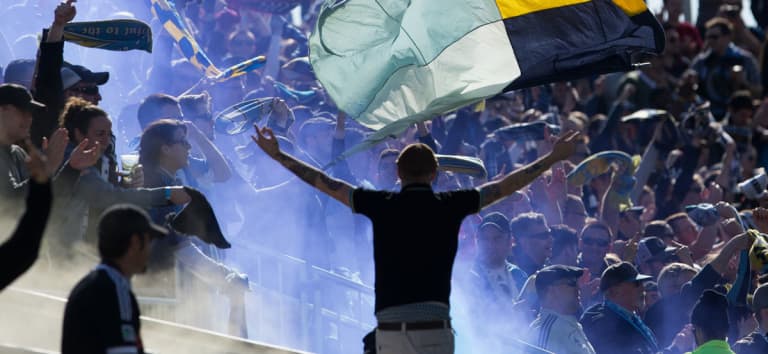
Back to the field, a capo encourages the Sons of Ben to support the Union. USA Today Sports Images
Another sacrifice comes in the form of the physical toll being an active capo can take on your body. A sore throat from prolonged screaming over the course of 90 minutes often accompanies bruises, cuts and scrapes that come as a result of jumping, dancing and cajoling in the capo stand during a match.
Because it’s such a high-intensity experience, capos rotate in and out during matches to give each other breathers. The cycle also allows a new crop of supporters to earn their own experience – an important step and rite of passage in making sure support stays strong over the years.
“This generation of people older than me, they’re waiting longer to have kids. When those people hit their 30s, they see these kids that are also coming to matches – young helpful hands that want to get involved,” Murray says of his experience in Portland. “For the people that don’t have sons or daughters of their own, that’s the easiest way to pass on what they do to make sure that the support remains strong and is always happening.”
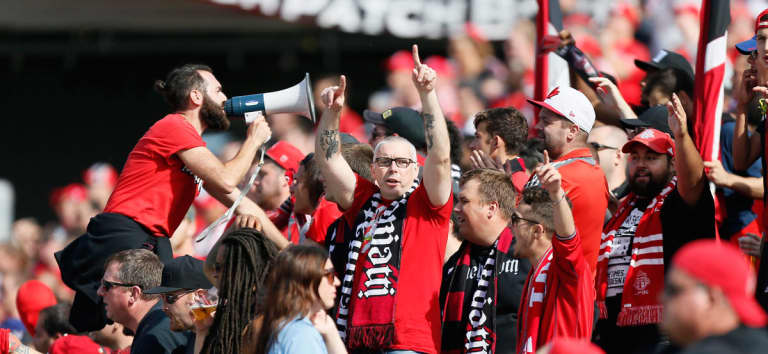
A capo armed with a megaphone leads Toronto FC supporters in song at BMO Field. USA Today Sports Images
At age 29, Stanton is entering his 11th season in the capo stand. He sees his own retirement on the horizon, and with it a mission to pass the torch to a new generation in Chicago.
“Thirty in capo years is like age 90. I don’t know if my body can keep going like this for more than a season or two,” he says. “The physical nature catches up with you a bit and the rest of life can get in the way. It’s not that you’re not as passionate or devoted, you just have to realize you can’t do it the same way. I’m sure four years from now I’ll still try and make my cameos in the capo stand, but I truly hope that someone will come along that plans on devoting the next five years of their life to loving the Fire like nothing else.
“That’s what it takes to be a leader.”

